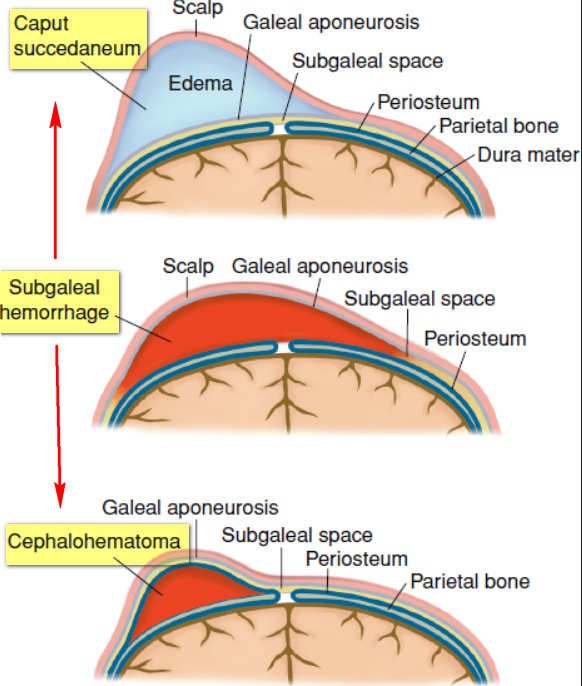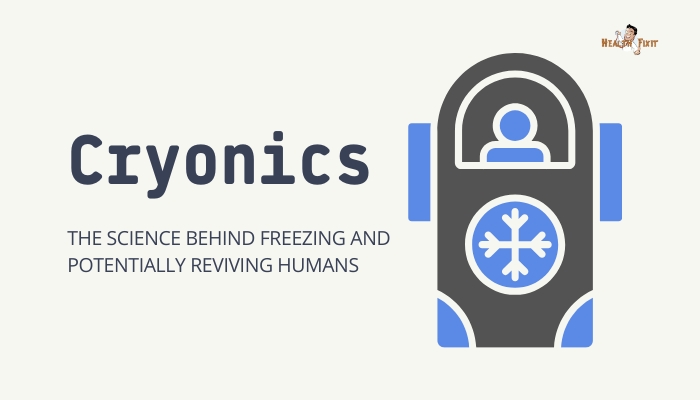Definition
A cephalohematoma is a hematoma (blood clot) in the area between the skull and periosteum (membrane covering the skull) secondary to ruptured blood vessels.
It does not cause any harm to the brain cells, but the unnecessary pooling of the blood can be very alarming. It affects about 2% of all live births. It is considered a minor injury and usually heal on its own. It does not possess any major medical problems. (1, 2)
Symptoms and Signs
The clinical manifestations of severe cephalohematoma are yellowish discoloration of the skin (jaundice), low blood pressure, and anemia.
Anemia and high number of bilirubin in the blood are the two primary complications of cephalohematoma. An infection is also possible and usually a result of attempting to drain the blood. (1, 2,3)

Image 1 : An image of an infant with a visible cephalohematoma.
Photo Source : s-media-cache-ak0.pinimg.com

Picture : An anatomy of the infant’s head and the different locations of possible injury.
Photo Source : www.abclawcenters.com
Cephalohematoma vs Caput succedaneum
A caput succedaneum is an edema of the presenting part of the head of the baby. The swelling crosses the suture lines. Typically, the edema is just about the size of the large egg, but it can also spread in wide areas of the head.
The swelling is soft and puppy in nature. It may or may not have bruising or discoloration of the skin. On the other hand, cephalohematoma is a blood clot that appear in their sides of the head. It is usually found over the occipital bone.
The edema is not present at birth. It occurs within 24 to 48 hours after giving birth. There is an obvious skin discoloration and has visible edges at the end of the suture lines. (8, 9,10)

Image 3 : A comparison image of cephalohematoma and caput succedaneum.
Picture Source : s-media-cache-ak0.pinimg.com
Cephalohematoma Causes
- Prolonged labor – During delivery, the body of the baby is experiencing a large amount of stress as it travels through the birth canal, going to the pelvis, and out of the vagina. The compression could lead to bruising and swelling in various parts of the body. If the baby has cephalohematoma, it is an indicator that the mother undergone a long and difficult delivery.
- Size of the baby – Cephalohematoma is most likely to happen in large fetus. It takes longer to deliver and finds it extremely difficult to mold to the size of the birth canal. The possibility of having cephalohematoma is higher in cephalo-pelvic disproportion (relationship between the mother’s pelvis and baby’s head). Typically, cephalohematoma is common in first pregnancy.
- Assisted-delivery tools – When the mother is having a hard time delivering the baby, the doctor will use tools to help deliver the baby such as forceps or vacuum extraction. In rare circumstances, these tools could cause cephalohematoma. (3, 4,5)
- Medical malpractice – Mistakes made by the medical staff could lead to cephalohematoma and other types of preventable birth injuries. It could be in the form of not using the right forceps during forceps delivery. Another ground is not paying much attention to cephalo-pelvic disproportion leading to difficult and prolonged labor. In the case of severe cephalo-pelvic disproportion, the patient is advised to undergo caesarean section. (5)
Cephalohematoma Complications
When it comes to cephalohematoma in infants, health care professionals won’t do anything about it because it usually goes on its own. However, there are symptoms where immediate treatment is needed such as yellowish discoloration of the skin and low blood count.
To avoid any complications, the infant should be thoroughly assessed no matter how minor it may appear at first. Additional treatments may be required such as using bili light to break up bilirubin and blood transfusion. (5, 6)
How to diagnose cephalohematoma?
A differential diagnosis is ordered to check for the extent of haemorrhage. Extensive haemorrhage can take place between the scalp and above the periosteum. Imaging studies are also ordered such as CT scan, x-ray of the skull, and magnetic resonance imaging (MRI).
These are the diagnostic procedures needed in patients demonstrating neurologic symptoms. The attending physician will also conduct a thorough physical assessment to determine the extent of the problem. (7)
How does Cephalohematoma cause jaundice?
A jaundice is a yellowish discoloration of the skin secondary to high level of bilirubin in the blood. Cephalohematoma can actually cause jaundice as the blood compensates to replace the lost red blood cells.
If the amount of red blood cells is sufficient, the liver will eventually get rid of the excess bilirubin in the blood. In severe case of jaundice, the baby is exposed to blue light or bilirubin light to facilitate the breakdown of bilirubin in the skin. (7, 8)
How long does it take for a Cephalohematoma to go away?
It usually takes a few weeks or months for the cephalohematoma to completely go away. The middle portion of the bump disappears first. The surrounding skin becomes rigid because of calcium deposits.
As the middle of the bump disappears, the remaining part looks like a crater. Don’t worry though as it just normal. It is a sign that the cephalohematoma is slowly fading. After weeks or months, cephalohematoma will completely go away. (8)
Cephalohematoma Treatment
The word cephalohematoma may sound alarming the minute you hear it. There is really nothing to worry because it does not possess any risk to the brain cells. However, you should carefully monitor your baby for any signs of neurologic disturbances.
Severe blood clot may later on contribute to the development of cerebral palsy and other forms of developmental disorders. Cephalohematoma usually subsides on its own within a few weeks. If the cephalohematoma won’t seem to go away after a long period of time, then you should immediately contact your paediatrician.
The doctor will thoroughly assess the condition of the patient and will come up with the best treatment and management approach. (9, 10,11)
References:
- www.birthinjuryguide.org
- https://en.wikipedia.org
- www.cerebralpalsysymptoms.com
- www.davislevin.com
- www.medicinenet.com
- www.uptodate.com
- www.consultant360.com
- www.crowemulvey.com
- www.impcna.com
- www.academyofneonatalnursing.org
- Manual of Neonatal Care edited by John P. Cloherty, Eric C. Eichenwald, Ann R. Stark



